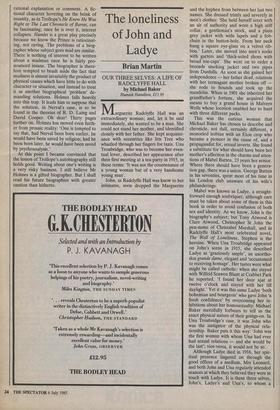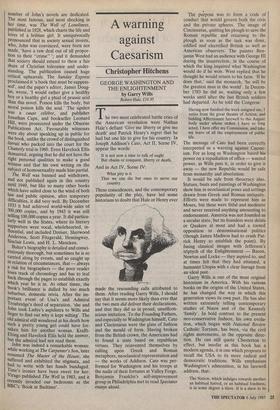The loneliness of John and Ladye
Brian Martin
OUR THREE SELVES: A LIFE OF RADCLYFFE, HALL by Michael Baker
Hamish Hamilton, £13.95
Marguerite Radclyffe Hall was an extraordinary woman; and, let it be said immediately, she wanted to be a man. She could not stand her mother, and identified closely with her father. She kept acquaint- ance with eccentrics like Iris Tree who whistled through her fingers for taxis. Una Troubridge, who was to become her even- tual lover, described her appearance after their first meeting at a tea-party in 1915, in these terms: 'It was not the countenance of a young woman but of a very handsome young man'.
John, as Radclyffe Hall was know to her intimates, soon dropped the Marguerite and the hyphen from between her last two names. She dressed trimly and severely in men's clothes: 'She held herself erect with an air of authority and wore a high stiff collar, a gentleman's stock, and a plain grey jacket with wide lapels and a fob- chain in the button-hole. From her neck hung a square eye-glass on a velvet rib- bon.' Later, she moved into men's socks with garters and 'thick-soled shoes with broad toe-caps'. She went on to order a brocade smoking jacket and two pipes from Dunhills. As soon as she gained her independence — her father dead, relations with her termagant mother broken off — she rode to hounds and took up the mandolin. When in 1901 she inherited her grandfather's fortune, she acquired the means to buy a grand house in Malvern Wells whose location enabled her to hunt with three different packs.
This was the curious woman that Michael Baker has chosen to describe and chronicle, not dull, certainly different, a monocled lesbian with an Eton crop who became a pioneer in the cause of, and a propagandist for, sexual inverts. She found a substitute for what should have been her mother's affection in the charms and atten- tions of Mabel Batten, 23 years her senior. Where there should have been a genera- tion gap, there was a union. George Batten in his seventies, spent most of his time in his London club unaware of his wife's philanderings.
Mabel was known as Ladye, a straight- forward enough soubriquet, although care must be taken about some of them in this book in order to avoid confusion of both sex and identity. As we know, John is the biography's subject; but Tony Atwood is Clare Atwood, Christopher St John the pen-name of Christabel Marshall, and in Radclyffe Hall's most celebrated novel, The Well of Loneliness, Stephen is the heroine. When Una Troubridge appeared on John's scene in 1915, she described Ladye as 'graciously ample', an unortho- dox grande dame, elegant and 'accustomed to receiving homage'. Her tastes were what might be called catholic: when she stayed with Wilfrid Scawen Blunt at Crabbet Park he reported, 'I found her door ajar at twelve o'clock and stayed with her till daylight.' Yet it was this same Ladye 'both bohemian and bourgeois' who gave John 'a fresh confidence' by overcoming her in- hibitions about her homosexualty: Michael Baker mercifully forbears to tell us the exact physical nature of their goings-on. In Una Troubridge's case, it was John who was the instigator of the physical rela- tionship. Baker puts it this way: 'John was the first woman with whom Una had ever had sexual relations — and she would be the last': vice-versa, it would not be so.
Although Ladye died in 1916, her spir- itual presence lingered on through the good offices of a medium, Mrs Leonard, and both John and Una regularly attended seances at which they believed they were in touch with Ladye. It is these three selves, John's, Ladye's and Una's, to whom a number of John's novels are dedicated. The most famous, and most shocking in her time, was The Well of Loneliness, Published in 1928, which charts the life and loves of a lesbian girl. It unequivocally Pronounced that in society sexual inverts, Who, John was convinced, were born not made, 'have a raw deal out of all propor- tion to their "crime" '; and it demanded that society should extend to them a fair share of Christian tolerance and under- standing. The publication caused huge critical upheavals. The Sunday Express Proclaimed it 'a book that must be suppres- sed', and the paper's editor, James Doug- las, wrote, 'I would rather give a healthy boy or a healthy girl a phial of prussic acid than this novel. Poison kills the body, but moral poison kills the soul.' The upshot was a cause célèbre, and publisher Jonathan Cape, and bookseller Leonard Hill, were prosecuted under the Obscene Publications Act. Favourable witnesses were shy about speaking up in public for the book, unlike the crowd of distinguished literati who packed into the court for the Chauerly trial in 1960. Even Havelock Ellis demurred, arguing that he did not have the right personal qualities to make a good witness and that his own writing on the subject of homosexuality made him partial. The Well was banned and withdrawn, and not published again in this country until 1949, but like so many other books Which have sailed close to the wind of both law and public opinion, after temporary difficulties, it did very well. By December 1933 it had achieved world-wide sales of 300,000 copies, and by 1943 it was still selling 100,000 copies a year. It did particu- larly well in the States, where its literary supporters were vocal, wholehearted, in- fluential, and included Dreiser, Sherwood Anderson, Scott Fitzgerald, Hemingway, Sinclair Lewis, and H. L. Mencken.
Baker's biography is detailed and consci- entiously thorough, but sometimes he is so carried along by events, and so caught up in relation of circumstances, that — always a risk for biographers — the poor reader loses track of chronology and has to leaf back through the pages to establish exactly Which year he is in. At other times, the book's brilliance is dulled by too much suburban, domestic trivia. After the im- portant event of Una's and Admiral Troubridge's deed of separation, 'she and John took Ladye's aspidistra to Wills and Seger to find out why it kept wilting'. The old admiral still wondered at his death how such a pretty young girl could have for- saken him for another woman. Krafft- Ebing and Havelock Ellis held the answer, but the admiral had not read them.
John was indeed a remarkable woman: While working at The Carpenter's Son, later renamed The Master of the House, she suffered and exhibited the stigmata, and had to write with her hands bandaged. Time's ironies have been sweet for her: Virago published The Well in 1983, and it recently invaded our bedrooms as the BBC's 'Book at Bedtime'.



















































 Previous page
Previous page